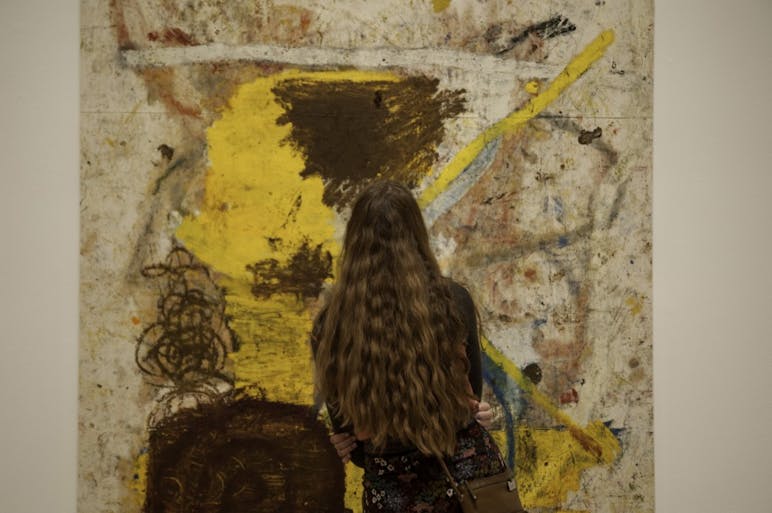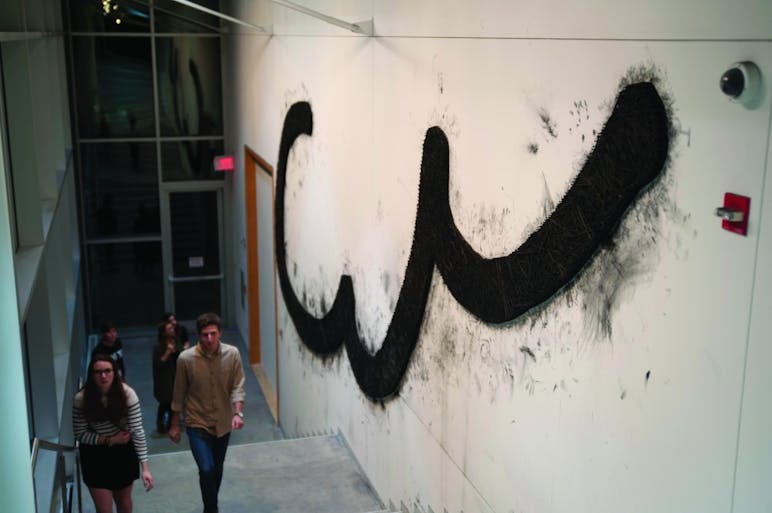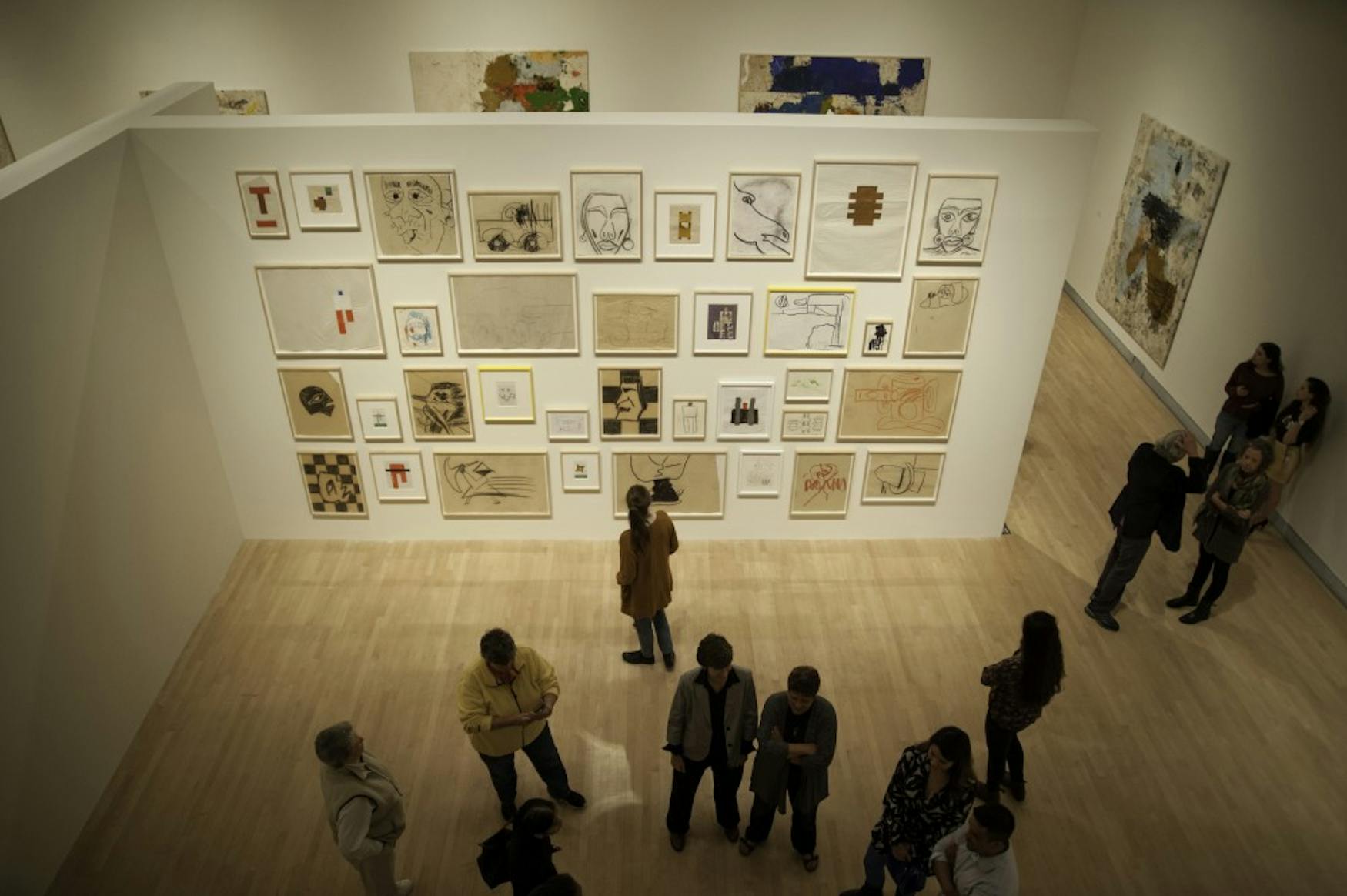Rose Art Museum opens fall exhibitions
Bright strokes of color extend across unstretched canvas, overlapping in loud, sporadic strokes. Simple pedestals dot the floor, displaying equally brightly painted statues — a TV, a face, a pair of feet. A large doorless file cabinet, Pepto-Bismol pink, stands in the center of an enclave. On another wall, a small collage of pamphlet advertisements sits among a collection of cartoons in various states of refinement. These are some of the things you might see when you first enter the Rose Art Museum’s solo exhibition of New York artist Joe Bradley.
The exhibition is one of five currently on display at the Rose Art Museum, which held its opening event Saturday. The event drew people of all ages, including several professors, and featured refreshment tents and food trucks in addition to the art.

PAINTING AND LIFE: A museum guest stands before a Joe Bradley painting.
The event was also attended by Kevork Mourad, a Syrian-Armenian artist whose work is on display in the Mildred S. Lee Gallery. The exhibition is titled “Immortal City” and portrays the pain of those who are suffering in the Syrian war, in which 465,000 people have perished, according to a March 13 Reuters article. The centerpiece of the exhibit, a wall-sized, three-layer mixture of ink drawing and painting, depicts the ruins of Aleppo and contorted bodies in heartwrenching detail. Clad in simple black, complete with a leather jacket and his demeanor revealing none of the pain of his work, Mourad stood by to answer questions of those attending.
The largest exhibition was that of the work of Bradley, who is widely known for his expressionistic, abstract work. It features a mixture of his color-field paintings, grease-pencil drawings and bronze statues. One work, the “Fisherman’s Friend,” is a collection of single-color canvasses, three in classic mackintosh yellow and a fourth the dingy white of a sailor’s cap. Bradley has identified his artistic process as a sort of “glitching,” shifting erratically from one work to another and putting bits together, and he uses his work to explore the elements of painting and the chaos of studio work that have fascinated him throughout his career.
The exhibition of Bradley’s work, curated at the Rose by Kim Conaty, is the first of its size in North America, and it is accompanied by a publication featuring essays on Bradley’s painting.
Alongside Bradley’s work is the artist’s selection (Buckdancer’s Choice) of the museum’s holdings. Placed before the entrance to Bradley’s solo exhibition so as to allow viewers to engage with Bradley’s influences before experiencing his own work, the selection contains masterworks by the likes of Paul Cezanne and Max Ernst as well as lesser-known pieces from the collection.
The 11th installment of the museum’s Rose Video series, titled “Auto Da Fe,” or “act of faith,” is a two-channel video exploring historical migrant crises that have forced the persecuted to flee across the sea. By Ghanaian artist John Akomfrah, the video utilizes powerful imagery to relate the flight of Sephardi Jews in 1654 to the modern Syrian refugee crisis.

ARTISTIC GESTURE: Student guests walk up the stairs next to Tony Lewis’ installation made of graphite dust, nails and rubber bands, titled "Plunder."
A permanent installation in the museum, titled “The Undisciplined Collector,” celebrates the Rose Art Museum’s founding and Brandeis’ history of collecting valuable pieces of culture and history. Entering the wood-paneled room feels as though you have travelled back in time nearly 50 years. The solid wooden cabinets are filled with books, East Asian bottles and African statues and are topped with bakelite appliances and a record player playing low jazz. On the walls, a collection of works ranging from impressionistic paintings to detailed line drawings completes the ambiance.
As you enter the museum, the first exhibition you encounter, titled “Body Talk,” explores the tension, agony and ecstasy of the human body through a wild collection of paintings, collages and statues. The exhibition contains abstract depiction of the human body by Surrealist-inspired artist Max Weber and works by Joseph Cornell that explore his fascination with the various female forms. Also featured in the exhibition is a commentary on the Scarlet Letter — “The Interior of the Heart” — by Tim Rollins and the piece “Large Slides” by Ross Bleckner, which depicts multiplying shapes reminiscent of red blood cells in a requiem for the AIDs epidemic.
The evening brought the community together to enjoy the food, company and art. The exhibitions will be on display for another two months.
—Editor’s Note: Hannah Kressel, the editor of the Arts Section of the Justice works is a guide at the Rose and a member of the Student Committee for the Rose Art Museum.



Please note All comments are eligible for publication in The Justice.